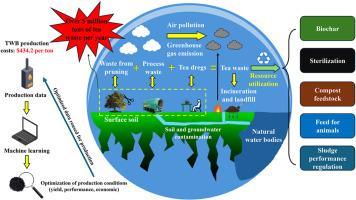茶叶废弃物在生物炭等领域的资源化利用:现状、挑战与未来展望
IF 8.4
2区 环境科学与生态学
Q1 ENVIRONMENTAL SCIENCES
引用次数: 0
摘要
茶是最受欢迎的非酒精饮料之一,其消费量稳步增长,导致全球茶叶产量大幅上升,因此每年产生大量茶叶废物。仅中国每年就产生超过500万吨的茶叶废物,包括修剪过的茎、丢弃的叶和芽、制造过程中的废物以及冲泡后的残渣。茶叶中含有丰富的多酚、多糖、氨基酸、生物碱等活性物质。利用大量的茶叶废料可以在各个部门生产具有成本效益的衍生品,从而提高其实用价值,促进循环经济,实现“废物变现”。本研究旨在评价茶叶废弃物资源化利用的多种应用潜力。综述了茶叶废弃物在生物炭、堆肥原料、污泥性能改性剂、消毒杀菌剂、动物饲料等方面的应用研究现状。本研究着眼于茶渣生物炭(TWB)的制备和应用,确定了当前TWB生产技术的几个局限性,包括与性能、产量和经济可行性相关的挑战。结合文献计量学分析,机器学习方法已经成为评估和预测生物炭性能以及优化生物炭生产过程的有价值的工具。对TWB生产成本的经济评价表明,其生产成本(434.2美元/吨)低于玉米秸秆(454.19美元/吨)和小麦秸秆(448.01美元/吨),但高于水稻秸秆(425.73美元/吨)。此外,分析强调热解时间和加热速率是影响生产成本的关键因素,与先前的研究相比,提供了新的见解。本文综述了茶叶废弃物在生物炭领域的研究进展和面临的挑战,并展望了未来的发展方向。研究结果将为茶叶废弃物的可持续利用提供依据,并有助于从多方面开发利用这一丰富而廉价的废弃生物质。本文章由计算机程序翻译,如有差异,请以英文原文为准。

Resource utilization of tea waste in biochar and other areas: Current status, challenges and future prospects
The consumption of tea, one of the most popular non-alcoholic beverages, has steadily increased, leading to a significant rise in global tea production and consequently the generation of substantial amounts of tea waste annually. China alone generates more than 5 million tons of tea waste annually, comprising trimmed stems, discarded leaves and buds, waste from the manufacturing process, and residue after brewing. Tea is rich in polyphenols, polysaccharides, amino acids, alkaloids, and other active substances. Leveraging substantial quantities of tea waste can produce cost-effective derivatives across various sectors, thereby enhancing its utilitarian value and promoting a circular economy, for "Waste to Treasure". This study aims to evaluate the potential for resourceful utilization of tea waste in diverse applications. The current state of research concerning various applications of tea waste, including its use in biochar, composting feedstock, sludge performance modifiers, disinfection and biocides, as well as animal feed is comprehensively summarized. Focusing on the preparation and application of tea-waste-derived biochar (TWB), this study identifies several limitations in current TWB production technologies, including challenges related to performance, yield, and economic viability. Combined with bibliometric analysis, machine learning methods have emerged as valuable tools for evaluating and predicting biochar performance, as well as optimizing the biochar production process. An economic assessment of TWB production costs revealed that its production cost ($434.2/ton) is lower than that of corn stover ($454.19/ton) and wheat straw ($448.01/ton), but higher than rice straw ($425.73/ton). Furthermore, the analysis highlighted pyrolysis time and heating rate as critical factors influencing production costs, offering new insights compared to prior studies. This paper summarizes the progress and challenges faced by tea wastes in the field of biochar and looks at future directions. Results will provide sustainable utilization of tea waste and assist in exploiting this abundant and cheap waste biomass in many ways.
求助全文
通过发布文献求助,成功后即可免费获取论文全文。
去求助
来源期刊

Journal of Environmental Management
环境科学-环境科学
CiteScore
13.70
自引率
5.70%
发文量
2477
审稿时长
84 days
期刊介绍:
The Journal of Environmental Management is a journal for the publication of peer reviewed, original research for all aspects of management and the managed use of the environment, both natural and man-made.Critical review articles are also welcome; submission of these is strongly encouraged.
 求助内容:
求助内容: 应助结果提醒方式:
应助结果提醒方式:


